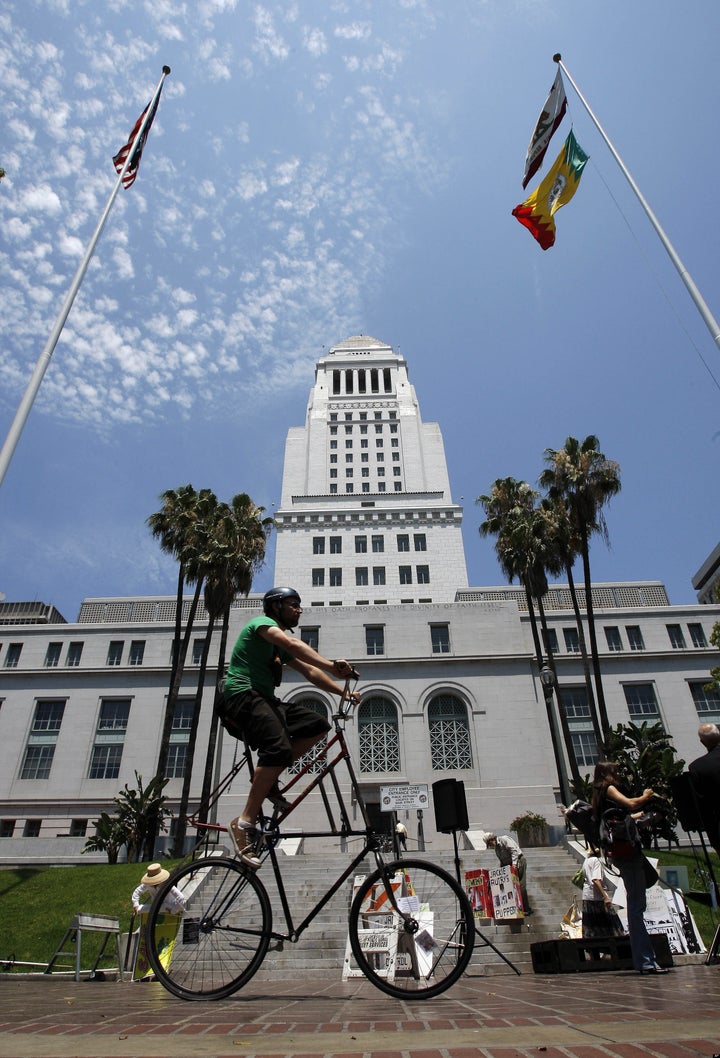
The Obama administration has signaled that its priorities for urban development will be metropolitan; it intends to improve livability throughout our metropolises and stop the spread of sprawl by directing investment into cities and already-built suburbs. As if on cue, books are appearing with instructions for doing so.
A few weeks ago I reviewed one of them here -- The Smart Growth Manual (SGM). The American Planning Association has published its own how-to urbanism book. Written by architect Nathan Cherry (with Kurt Nagle), the title is Grid/Street/Place: Essential Elements of Sustainable Urban Districts.
Grid/Street/Place (G/S/P) has much in common with the SGM. Both books explain and promote similar concepts, such as the importance of mixed-use development, density, walkability, managing automobiles and parking, etc.
G/S/P is also a kind of manual; author Cherry describes it as a "playbook" in his introduction. The instructions come largely in visual form: primarily by way of maps of places the authors consider worthy of study. The examples fall into five principal categories: Classic Districts (which give a historic perspective); Mixed Use Districts; Squares, Greens and Parks; Shopping Streets; and Places. The maps in any section are at the same scale, to facilitate comparisons.
The data in the book, however, are not limited to physical form. The section on Mixed Use Districts, for instance, includes separate maps showing not only the layout of buildings, but also circulation, land-use mix, commercial mix, residential mix, and the open space network. Then the maps are followed by graphs comparing the districts by how they allocate land uses, how much density they have, etc. In the section on open spaces, the authors include sectional drawings showing the spatial enclosure.
The explicit purpose of the book is to assist the development of metropolises that are "sustainable" and, with a nod to Kevin Lynch, "legible." This will require, according to the authors, a regional approach that means reinvestment in urban cores, making existing suburbs more livable, and combating further sprawl. They make the points that environmental sustainability in the urban context will come from growing and renewing what we have -- "urban cores" and "inner-ring suburbs and municipalities" -- to create "exciting and unique places in which to live", and that sustainability is more than "green roofs and recycled materials."
As expressed in the book's title, Cherry and Nagle work from a structure based on a hierarchy of increasing detail -- from grid, to street, to place. (This is another similarity to the SGM, which was also hierarchical. The SGM started "bigger," however, and ended up "smaller," as its hierarchy went from region, to neighborhood, to street, to building.)
It's significant that Cherry and Nagle start with the grid, because since ancient times the grid has differentiated the town from the countryside. It's "on the grid" that the book diverges from the SGM. While the SGM largely drew its examples from contemporary developments built as new communities, most of the recent examples in G/S/P are of developments that have recycled land that was already within an urban and existing suburban grid.
Indeed, Cherry in effect dedicates the book to Los Angeles, the city famous for its seemingly unending grid. In the acknowledgments section, he writes:
This project would not have been possible without metropolitan Los Angeles itself. It is both the dynamism and dysfunction of this city that calls forth the fundamental need to seek out, learn from, and implement progressive ideas that can capture the promise of the future.
Although the dynamism (and, lamentably, the dysfunction) of Los Angeles is characteristically expressed in individual developers' small and often idiosyncratic projects spread around the grid, the book is weighted in favor of large planned developments. These include in the inner Los Angeles region recent developments such as Americana at Brand, L.A. Live, The Grove, Playa Vista, and One Colorado; in suburban L.A. and Orange County, Valencia Town Center and a planned development in Tustin on a former Marines base called Legacy Park; and outside of southern California, Addison Park near Dallas. (The authors' firm, RTKL Associates, designed some, but by no means all, of these projects.)
My only disappointment with the book is that contains only a few examples of places that developed "organically" (i.e., as a result of pluralistic decision-making) in recent years on top of an existing layout of streets. While a "convulsive" approach to development (to borrow a term from Dana Cuff's book, The Provisional City: Los Angeles Stories of Architecture and Urbanism (2000)) links design-oriented movements like Modernist Urbanism with sprawl developers of everything from housing subdivisions to office parks, G/S/P is eclectic about architecture and with only a few exceptions avoids using recent examples of building outside of existing cities or close-in suburbs. I was therefore surprised not to have seen in the book more examples of places that evolved "lot-by-lot" (or at the most, "block-by-block") rather than by means of a developer with a plan (and a bulldozer).
For instance, the revival of downtown Los Angeles as a residential district over the past 20 years is a great story, as old office buildings have been turned into apartments, new apartments have been built, major cultural and entertainment institutions have been constructed, and recently a full-service supermarket opened, bringing groceries downtown for the first time in decades. It's not a slight to anyone to say that the revival of downtown L.A. as a whole is a bigger story for creating "exciting and unique places in which to live" than, say, L.A. Live, which is just one component of it.
Frank Gruber writes a weekly column on local politics, which often involve land use issues, for the Santa Monica Lookout News, a news website. His first book, Urban Worrier: Making Politics Personal, was published last year by City Image Press.